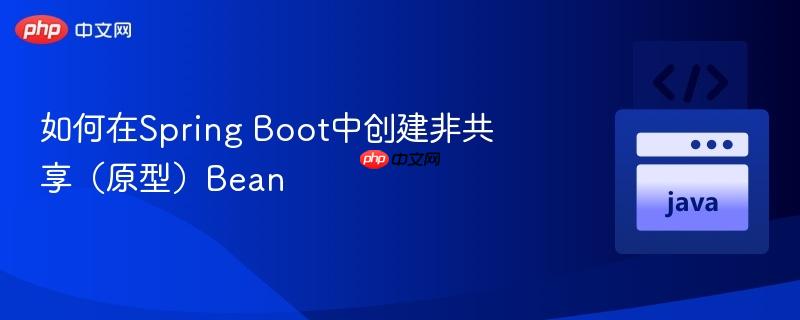
在spring Boot中,默认的`@Bean`声明会创建单例(Singleton)Bean,即所有注入点共享同一个实例。本文将详细阐述如何通过使用`@Scope(“prototype”)`注解,为每个注入请求生成独立的非共享(原型)Bean实例。这对于管理像`RestTemplateBuilder`这类具有状态的组件至关重要,以避免因状态共享导致的副作用,确保组件行为的独立性。
理解spring boot Bean的默认作用域
在spring框架中,通过@Configuration类中的@Bean方法声明的组件,其默认作用域是“单例”(Singleton)。这意味着Spring IoC容器只会为该Bean创建一个实例,并在所有需要注入该Bean的地方共享这同一个实例。这种设计模式在大多数情况下是高效且内存友好的,因为它避免了不必要的对象创建。
然而,对于某些特定场景,单例模式可能会引入问题。例如,当一个Bean是“有状态的”(Stateful),即其内部属性会随着业务逻辑的执行而改变时,如果多个组件共享同一个实例,一个组件对该实例状态的修改可能会意外地影响到其他组件,导致难以追踪的副作用。RestTemplateBuilder就是一个典型的例子。它是一个构建器,用于配置RestTemplate实例,其内部可能包含一些构建过程中的瞬时状态。如果所有服务都共享同一个RestTemplateBuilder实例,一个服务对它的配置修改可能会意外地影响到其他服务创建的RestTemplate。
创建非共享(原型)Bean
为了解决有状态Bean的共享问题,Spring提供了“原型”(Prototype)作用域。当一个Bean被定义为原型作用域时,spring容器会在每次注入或通过getBean()方法请求该Bean时,都创建一个全新的实例。这确保了每个使用方都拥有自己独立的Bean实例,从而避免了状态共享带来的潜在问题。
要将一个@Bean方法定义为原型作用域,只需在其上添加@Scope(“prototype”)注解即可:
import org.springframework.context.annotation.Bean; import org.springframework.context.annotation.Configuration; import org.springframework.context.annotation.Scope; @Configuration public class appConfig { // 假设Person是一个有状态的类,或者我们希望每次注入都得到一个新实例 @Bean @Scope("prototype") // 声明为原型作用域 public Person personPrototype() { System.out.println("Creating a new Person instance..."); return new Person("John Doe", 30); } // 示例:一个使用Person Bean的组件 // 每次注入PersonService时,它将获得一个全新的Person实例 @Bean public PersonService personService1(Person personPrototype) { System.out.println("PersonService1 created with Person instance: " + personPrototype.hashCode()); return new PersonService(personPrototype); } @Bean public PersonService personService2(Person personPrototype) { System.out.println("PersonService2 created with Person instance: " + personPrototype.hashCode()); return new PersonService(personPrototype); } } // 假设的Person类 class Person { private String name; private int age; public Person(String name, int age) { this.name = name; this.age = age; } // getters and setters public String getName() { return name; } public void setName(String name) { this.name = name; } public int getAge() { return age; } public void setAge(int age) { this.age = age; } @Override public String toString() { return "Person{" + "name='" + name + ''' + ", age=" + age + '}'; } } // 假设的PersonService类 class PersonService { private final Person person; public PersonService(Person person) { this.person = person; } public void doSomething() { System.out.println("Service using person: " + person.getName() + ", hash: " + person.hashCode()); } }
在上述示例中,每次Spring容器需要注入Person类型的Bean时(例如注入到personService1和personService2中),都会调用personPrototype()方法,从而创建一个全新的Person实例。通过观察控制台输出的哈希码,可以验证personService1和personService2注入的是不同的Person实例。
使用常量定义作用域
除了直接使用字符串”prototype”,你也可以使用ConfigurableBeanFactory接口中定义的常量来指定作用域,这通常被认为是更健壮和可读性更高的方式:
import org.springframework.beans.factory.config.ConfigurableBeanFactory; import org.springframework.context.annotation.Bean; import org.springframework.context.annotation.Configuration; import org.springframework.context.annotation.Scope; @Configuration public class AnotherAppConfig { @Bean @Scope(value = ConfigurableBeanFactory.SCOPE_PROTOTYPE) // 使用常量定义原型作用域 public MyStatefulObject myStatefulObjectPrototype() { System.out.println("Creating a new MyStatefulObject instance..."); return new MyStatefulObject(); } } class MyStatefulObject { // ... 类的定义 }
ConfigurableBeanFactory.SCOPE_PROTOTYPE常量与字符串”prototype”具有相同的功能,但它提供了编译时检查,避免了因拼写错误导致的运行时问题。
何时选择原型作用域?
原型作用域并非万能,它有其特定的适用场景:
- 有状态的Bean: 当Bean内部包含可变状态,且这些状态不希望在不同使用者之间共享时,应使用原型作用域。RestTemplateBuilder就是一个很好的例子,它允许在构建RestTemplate时进行定制化配置,如果共享,一个服务的定制可能会影响到其他服务。
- 资源密集型操作: 如果Bean的创建或初始化成本较高,但每次使用都需要独立的配置或生命周期,原型作用域可以确保隔离性。
- 多线程环境: 在多线程环境中,如果一个单例Bean是有状态的,并且其状态会被多个线程并发修改,可能会导致线程安全问题。原型Bean为每个线程提供独立的实例,从而简化了线程安全管理。
注意事项
- 性能开销: 每次请求原型Bean都会导致新的对象创建和初始化。如果Bean的创建成本很高,或者Bean被频繁请求,这可能会对应用程序的性能产生一定影响。
- 生命周期管理: 与单例Bean不同,Spring容器对原型Bean的生命周期管理相对有限。Spring会负责创建和初始化原型Bean,但在Bean创建之后,容器将不再管理它的生命周期。这意味着,如果原型Bean持有一些需要释放的资源(例如文件句柄、数据库连接等),你需要自行在代码中处理这些资源的释放,Spring不会调用@Predestroy方法。
- 依赖注入的限制: 如果你在一个单例Bean中注入一个原型Bean,那么该单例Bean只会获得一次原型Bean的实例。如果你希望单例Bean每次使用时都获取一个新的原型Bean实例,你需要使用ApplicationContext.getBean()方法进行编程获取,或者使用ObjectFactory/Provider接口进行延迟查找。
总结
通过@Scope(“prototype”)注解,Spring Boot开发者可以灵活地控制Bean的作用域,从默认的单例模式切换到原型模式。这对于管理有状态的组件、避免副作用以及确保组件行为的独立性至关重要。理解不同Bean作用域的特性及其适用场景,是构建健壮、可维护Spring Boot应用的关键。在选择Bean作用域时,务必权衡性能开销和生命周期管理的复杂性,以做出最适合应用程序需求的决策。


